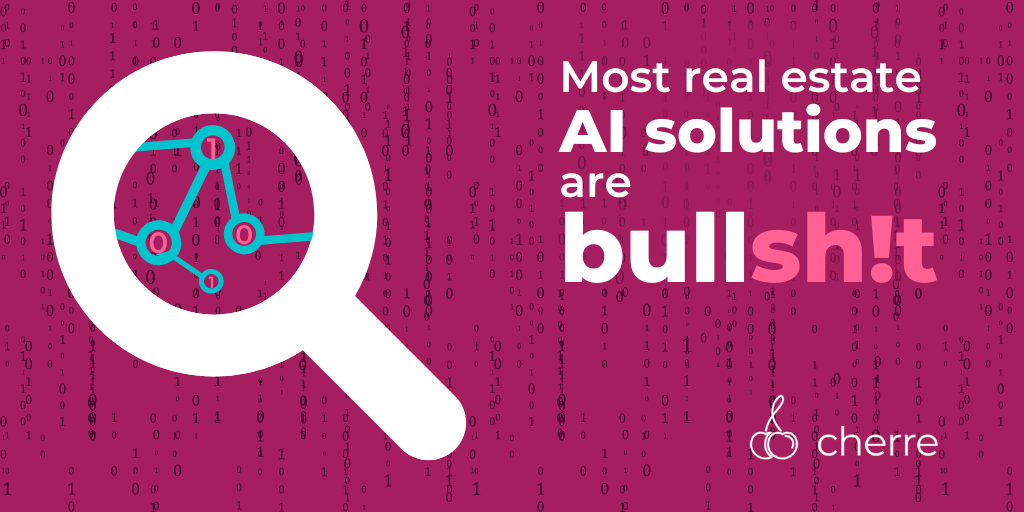
More than $23 billion is invested annually in real estate, according to Blueprint. With that much at stake, you need to be on your game to tell the difference between a time- and money-wasting AI solution and one that actually moves the performance needle.
The quality of your AI implementation goes hand-in-hand with the quality of your data and data strategy. Cherre specializes in transforming data (and therefore AI) into value, and we have some advice on the pitfalls to look out for when purchasing an AI solution.
In the fervor to embrace artificial intelligence, some organizations fall prey to the trap of implementing AI for AI’s sake (or because their board or boss said so). But implementing AI without first defining your strategic vision can lead to solutions in search of problems, resulting in wasted resources, misaligned objectives, and the adoption of tools that may not contribute meaningfully to your goals.
AI BS Radar Tip: There’s a real danger of wielding AI like a hammer in search of nails, especially when working with a vendor pushing a plethora of AI solutions. Before shopping for an AI solution, step back from technology to do some organizational planning. This will help you choose a strategic partner who understands your business, vision, and pain points – not just a vendor trying to make a sales quota.
The world of AI is inundated with complex terminology that can be confusing for decision-makers. From neural networks to machine learning algorithms, LLMs to GPTs, the excessive use of jargon often serves to obfuscate rather than enlighten. This language barrier can lead to misinformed decisions and investments in tools that may not align with your actual needs.
AI BS Radar Tip: You don’t have to know everything, but a good foundational knowledge of AI terms can help. If a vendor is overloading you with fancy words, don’t hesitate to interrupt and ask what something really means.
AI vendors often promise customized solutions to meet the unique needs of each client needs, but the reality is often underwhelming. They may provide only minor tweaks to standard products or opt for building from scratch, leading to high costs and prolonged timelines. Heavy customization can also result in products that are challenging to update with new data sources, application integrations, or changes in business strategy.
AI BS Radar Tip: If a vendor promises “customization,” probe into what that means. Can the data model bend and adjust to your changing needs? If the solution is being built from scratch just for you, dive deep into the timeline and what happens if you want to make changes down the road.
Related to the illusion of customization are AI “experts” who only specialize in AI. While these “specialists” may have an impressive resume, they may not have expertise in the built world. And that’s a real problem, because real estate data presents unique challenges that requires unique solutions.
AI BS Radar Tip: Ask the vendor to explain why real estate data is so problematic as compared to other types of data – not understanding is a huge red flag, regardless of how much experience they may claim to have with AI and data in the built world. Try also asking if data sources are already selected and how much data has already been standardized.
A significant issue with many AI strategies is the lack of transparency, often referred to as the “black box” conundrum. Users, including the experts implementing these tools, may not fully comprehend how AI algorithms arrive at their conclusions.
It’s hard to have trust in a model (and its conclusions) if the vendor can’t explain how it works. This opacity raises concerns about accountability, ethical considerations, and the potential for biased decision-making.
AI BS Radar Tip: Probe into how transparent the vendor’s algorithms are. Can they provide a clear breakdown of the algorithms and methodologies used in the AI solution? Can they share the data sources used to train the model?
AI should enhance and accelerate your decision-making, not replace it. The assumption that AI can replace human decision-making is not only unrealistic but can also result in critical errors that machines are ill-equipped to handle. The risk elevates as the decision impacts move higher in value. For example, informing a tenant of the amenities and hours in a building is low risk. Automating investment committee memo creation is problematic.
AI BS Radar Tip: No one knows your business better than you. Take the time to map how your business tasks can be automated or customized internally using generic models, custom models, or internal models — or how they should be externalized.
AI’s effectiveness is contingent on the quality and quantity of data available. Many organizations underestimate the challenges associated with collecting, cleaning, and maintaining the data feeding the model, whether it’s internal data, market data, or partner-submitted data.
Without a solid data foundation, AI tools can produce unreliable results – leaving you with incorrect data for your financials, deal modeling, and market selection.
AI BS Radar Tip: If your internal data or partner-submitted data will feed the data model, take a good look at whether your organization has the solid data foundation required to support quality AI. If you’re leveraging market data, ask the data provider or AI vendor how they are ensuring a high level of data quality and diversity.